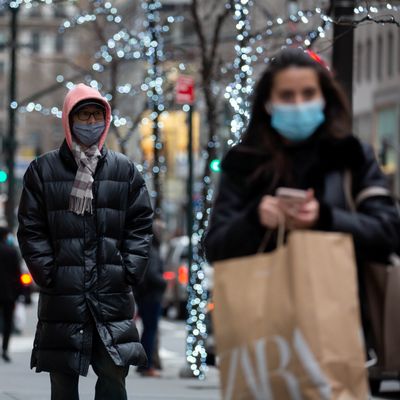
A new COVID-19 strain is spreading at an alarming rate in New York City, according to two academic studies submitted in February. The research from teams at Caltech and Columbia, which has not yet been peer reviewed, suggests that the variant known as B.1.526 could dampen the effectiveness of some current vaccine candidates. Below is everything we know about the research, the mutation, and how it may affect the pandemic in New York almost one year after the city was first inundated by the coronavirus.
How common is the new strain at this point?
The variant known as B.1.526 began showing up in samples collected in New York City in November. To chart its rise, Caltech researchers scanned for mutations among hundreds of thousands of COVID genetic sequences in a database known as GISAID. By mid-February, the Caltech team found that B.1.526 cases had risen to 27 percent of viral sequences in the database. Columbia researchers, meanwhile, sequenced 1,142 samples from patients at the university’s hospital and found that 12 percent had a case with E484K, one of the two variants that makes up B.1.526.
Dr. David Ho, one of the Columbia researchers, noted that cases in Westchester, the Bronx, and Queens suggest that there is some level of community spread involved with the new variant. “It’s not a single outbreak,” he told the New York Times.
Dr. Anthony Fauci, the director of the National Institute of Allergy and Infectious Diseases, says the homegrown variant likely originated in Washington Heights, a neighborhood in the uppermost area of Manhattan, before reaching other boroughs and is concerningly “gaining” across the city.
In New York City, the portion of new cases caused by this variant strain is a whopping 45 percent, according to city Health Department data from the first week of March. (In total, roughly 65 percent of new cases in the city during the last week were caused by variants, up from 52 percent.) The New York mutation has traveled extensively through the metropolitan region, and individual cases have also been found in 14 other states, including Texas, Wyoming, and Maryland.
“We certainly are taking the New York variant, the 526, very seriously,” Fauci said Monday in a White House press briefing.
It’s not known whether the strain, like other variants that have emerged the world over, is more transmissible than the original virus. At this point, more study and data is needed around the variant, but Fauci adds that officials need to “keep an eye” on the variant due to the possibility that it could evade the protection of antibody treatments and vaccines.
Fauci appeared on CBS’s Face the Nation last week, where he said the variant is “not widespread yet, but it seems to be spreading pretty efficiently through the New York City metropolitan area and beyond.” He adds that, while not as resistant as the quick-spreading variant originating from South Africa, this New York variant eludes “some of the protection of antibodies from monoclonal antibodies, as well as the vaccine.”
“The one thing you want to do is to make sure you do not allow that to continue to spread,” the nation’s top disease expert stressed.
How could this strain impact vaccinations?
Researchers at Caltech and Columbia determined that the strains found in New York, like other COVID variants, feature mutations on the virus’s spike protein, allowing it to penetrate into host cells and cause infections more effectively. B.1.526 is effectively two variants, featuring a pair of common mutations known as E484K and S477N — the latter of which “may affect how tightly the virus binds to human cells,” per the Times. According to a study from Columbia published in January, monoclonal antibodies made by Eli Lilly and Regeneron to treat COVID-19 have no effect against the South African strain, which also contains the E484K mutation. Other studies have also shown that variants with the E484K mutation are less susceptible to vaccines than the strain of the virus on which they were developed.
“It’s not particularly happy news,” Michel Nussenzweig, an immunologist at Rockefeller University, told the Times. “But just knowing about it is good because then we can perhaps do something about it.” Nussenzweig also said that the mutation blocks the activity of a common class of antibodies. “People who have recovered from the coronavirus or who have been vaccinated are very likely to be able to fight this variant off, there’s no doubt about that.” He added that “they may get a little bit sick from it.”
Fauci stressed that vaccination remains a key part of our pandemic-fighting toolkit, adding that the variant could have originated in an immunocompromised person. It’s “not only important for them [to get vaccinated] for their own health, but that could be the breeding ground of the emergence of variants,” Fauci says. “That was probably how all this started with 526.”
How worried should we be?
The two studies outlining the new COVID variant in New York made headlines last week, but some experts say it’s the latest example of the struggle to balance scientific validity, epidemiological relevance, and newsworthiness in the Wild West of COVID preprint studies.
“We know from many years of experience that any virus, particularly RNA viruses, are going to vary fairly extensively,” Colin Parrish, professor of virology at Cornell University, told Intelligencer. “There’s very little evidence that most of them will have much effect on the average person,” he said.
“We have to be very careful about presenting these stories that sound alarming. Everyone should really continue to do the best they can in terms of prevention control and getting vaccinated,” he added.
On Thursday, city health officials rushed to quell the public’s concern about the variant: “Not all variants are of public-health concern,” Dr. Jay Varma, senior public-health adviser to the mayor’s office said during a COVID briefing. “We need to just consider this a variant of interest — something that is interesting that we need to follow and track. But it doesn’t change anything about our public health concern. We need more data and studies to understand that.”
What other new COVID strains are circulating in New York?
On March 20, Governor Cuomo stated that New York has its first case of the Brazilian coronavirus variant. The patient, who is being treated at Mount Sinai Hospital, is a woman in Brooklyn in her 90s with “no travel history.”
The research on the new mutations in New York was made public the same week that it was announced that two residents of Nassau County were proven to have the South African variant. The Columbia team also confirmed that six cases of the U.K. variant, two cases of the Brazilian variant, and one case of the South African variant were detected in New York City.
As of March 21, coronavirus variants accounted for over 60 percent of new infections in New York City, as test positivity rates remain stubbornly high despite the nationwide dip.
That the coronavirus is changing in similar ways on different continents — the New York, Brazilian, South African, and British variants all feature the E484K mutation — suggest that the mutations have resulted in the more effective spread of the virus. “What we’re seeing is similar mutations arising in multiple places,” Adam Lauring, a virologist at the University of Michigan, told Scientific American in January. “That’s pretty suggestive that these mutations are doing something.” And though a two-dose regimen of the Pfizer shot has been proved to protect 90 percent of those inoculated against the U.K. and South African strains, the mutation of the virus over the past year shows that vaccines will need to be adjusted for the long run as the coronavirus becomes a part of life on Earth.
This post has been updated.





























